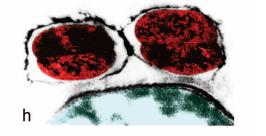Vampirococcus: Difference between revisions
No edit summary |
|||
| Line 21: | Line 21: | ||
==Description and significance== | ==Description and significance== | ||
Vampriococcus is one of few known predatory prokaryotes. It is a 0.6 micrometer, ovidal bacteria of which no modal forms have been found. It is a gram-negative bacteria that is found in freshwater sulfurous lakes in northern Spain.As an anaerobic epibiont, it attaches itself to the surface of phototropic bacteria, by specific structures, and as it grows and devides by fission, it destroys its prey [2]. | Vampriococcus is one of few known predatory prokaryotes. It is a 0.6 micrometer, ovidal bacteria of which no modal forms have been found. It is a gram-negative bacteria that is found in freshwater sulfurous lakes in northern Spain. As an anaerobic epibiont, it attaches itself to the surface of Chromatium a phototropic bacteria, by specific structures, and as it grows and devides by fission, it destroys its prey [2]. The structures used by Vampirococcus to attach itself to its prey could best be described as cytoplasmic "bridges." From these bridges, a connection is established to the prey which allows the Vampirococcus bacterium to degrade the preys cytoplasm [4] | ||
==Sources== | ==Sources== | ||
| Line 28: | Line 28: | ||
[2] Ricardo Guerrero,Carlos Pedros-Alio Et al. Predatory prokaryotes: Predation and primary consumption | [2] Ricardo Guerrero,Carlos Pedros-Alio Et al. Predatory prokaryotes: Predation and primary consumption | ||
evolved in bacteria, Evolution and Microbiology, Vol. 83, pp. 2138-2142, April 1986 | evolved in bacteria, Evolution and Microbiology, Vol. 83, pp. 2138-2142, April 1986 | ||
[4] Martin, Mark O. Journal of Molecular Microbiology and Biotechnology. Predatory Prokaryotes: An Emerging Research Opportunity, Vol. 4, Issue 5, pp. 467–477, 2002 | |||
Revision as of 23:40, 1 February 2012
Classification
Higher order taxa
Kingdom: Prokaryotae
- Domain: Bacteria
- Phylum: Unknown
- Class: Unknown
- Order: Unknown
- Family: Unknown
- Order: Unknown
- Class: Unknown
- Phylum: Unknown
As of 2008, "Phylogenetic Analysis of Vampirococcus and Daptobacter has yet to be undertaken...[1]"
Species
- Genus: Vampirococcus
- Species: Unknown
Description and significance
Vampriococcus is one of few known predatory prokaryotes. It is a 0.6 micrometer, ovidal bacteria of which no modal forms have been found. It is a gram-negative bacteria that is found in freshwater sulfurous lakes in northern Spain. As an anaerobic epibiont, it attaches itself to the surface of Chromatium a phototropic bacteria, by specific structures, and as it grows and devides by fission, it destroys its prey [2]. The structures used by Vampirococcus to attach itself to its prey could best be described as cytoplasmic "bridges." From these bridges, a connection is established to the prey which allows the Vampirococcus bacterium to degrade the preys cytoplasm [4]
Sources
[1] Whitworth, David E. "Myxobacteria [electronic resource] : multicellularity and differentiation" Washington, DC : ASM Press, c2008.
[2] Ricardo Guerrero,Carlos Pedros-Alio Et al. Predatory prokaryotes: Predation and primary consumption evolved in bacteria, Evolution and Microbiology, Vol. 83, pp. 2138-2142, April 1986
[4] Martin, Mark O. Journal of Molecular Microbiology and Biotechnology. Predatory Prokaryotes: An Emerging Research Opportunity, Vol. 4, Issue 5, pp. 467–477, 2002

